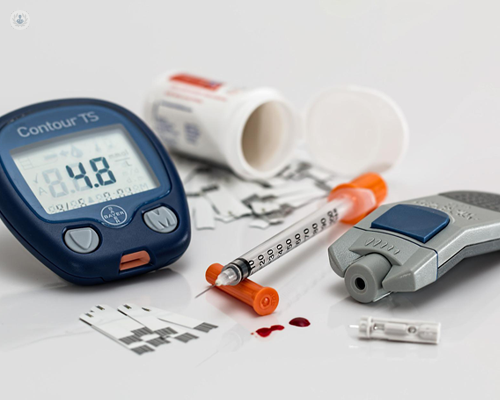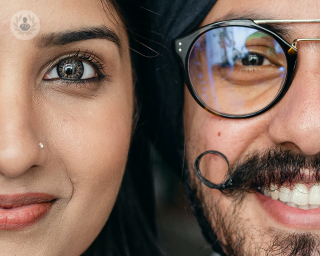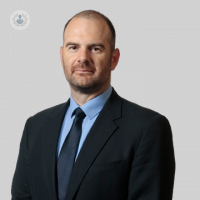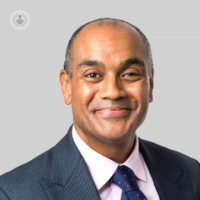Diabetes
Dr Mark Vanderpump - Endocrinology, diabetes & metabolism
Created on: 11-13-2012
Updated on: 02-06-2024
Edited by: Karolyn Judge
What is diabetes?
Diabetes mellitus (DM), or just diabetes, refers to a group of metabolic diseases which result in an inability to regulate blood sugar levels. Having too much glucose in your blood can damage the kidneys, eyes, nerves and other parts of the body, including the blood vessels themselves. In extreme cases, diabetes can cause heart disease and strokes, and patients may even require amputation of limbs.
This inability to control blood sugar comes from a problem with the hormone insulin. Insulin is produced by the pancreas, enters the bloodstream, and moves glucose out of the blood and into cells, where it is used to generate energy.
There are two types of diabetes:
- Type 1 diabetes – the cells that create insulin are attacked and destroyed by the body’s immune system as part of a defective immune response. It can develop rapidly over weeks or even days.
- Type 2 diabetes – either the body does not produce enough insulin, or the body’s cells stop responding to it. Patients may not be diagnosed for years, due to generic symptoms. It is by far the most common type of diabetes.
Other forms of diabetes include latent autoimmune diabetes in adults (LADA) which can present like type 2 diabetes but is a form of type 1 diabetes. It is often treated like type 2 diabetes but can rapidly progress to insulin dependence. Ketosis-prone diabetes, most commonly seen in people of African origin, can present with DKA but insulin requirements decline over weeks to months and insulin can often be stopped. Other types include rare genetic variants (Maturity-onset diabetes of the young (MODY)) and diseases of the pancreas such as pancreatitis or following pancreatic surgery.

What are the symptoms?
Classic diabetes symptoms include:
- Thirst
- Frequent urination
- Fatigue
- Itching around the genitals, or thrush.
- Weight loss/muscle loss
- Blurred vision
- Slow healing
- Vascular issues, such as diabetic foot.
- Diabetic neuropathy
- Diabetic nephropathy
- Diabetic retinopathy
What causes diabetes?
Type 1 diabetes is an autoimmune condition – something causes the immune system to attack healthy pancreatic cells that produce insulin. It appears to run in families, so may be genetic. No one knows exactly what causes the immune system to attack the pancreas, but one theory is that it is triggered by a virus. In rare cases, neonatal diabetes can occur at birth and is usually diagnosed within the baby's first nine months.
Type 2 diabetes is acquired, and usually affects older people. It tends to be associated with obesity and lack of exercise.
How can it be prevented?
Type 1 diabetes appears to be genetic, so there is no way to prevent it. To reduce the risk of developing type 2 diabetes, it is important to have a healthy and balanced diet, take plenty of exercise, and lose weight if you are overweight or obese. Stopping smoking and drinking alcohol in moderation are also useful tips.

What is the treatment?
Type 1 diabetes patients require regular insulin injections for the rest of their lives to make up for the lack of insulin production by the pancreas. Type 2 diabetes patients may eventually need to take tablets, as the condition is progressive (it will worsen over time).
Complications, such as diabetic foot, can sometimes be treated using vascular and microsurgery techniques. You should see your doctor or a specialist as soon as possible if you are experiencing symptoms. If diagnosed with diabetes, a patient is usually referred to a specialist care team for treatment and long-term monitoring of the condition.
What's the difference between type 1 and type 2 diabetes?
Type 1 and type 2 diabetes have many differences, alongside things in common. The main difference is that type 1 diabetes is a genetic condition that often presents itself early in life, while type 2 is related to lifestyle.
Both types have different methods of management, symptoms and risk factors as well as prevention. The things they share are mainly symptoms, which include:
- Being very thirsty
- Using the toilet more often, especially at night
- Feeling tired and fatigued
- Losing weight without effort
- Thrush and genital itching
- Cuts and wounds not healing as quickly
- Blurry vision
However, type 1 symptoms appear quite quickly, while type 2 diabetes symptoms can develop slower, so it makes it harder to distinguish symptoms. Sometimes, people can have diabetes up to 10 years without knowing.
It's also important that people with both type 1 and type 2 diabetes manage their symptoms via a healthy lifestyle. Some type 2 diabetes patients require insulin treatment, while type 1 diabetics must take insulin to control their blood sugar levels.
What are the complications of diabetes?
The damage that diabetes can do to your body are known as diabetes complications. The major complications can be separated into two types; chronic complications and acute ones. They go into further detail following our list of symptoms above.
Chronic complications
- Eye problems
Diabetic retinopathy is a condition that some people with diabetes can pick up.
- Foot problems
Amputation for diabetic foot problems can be an unfortunate eventuality if it is left untreated. Raised blood sugar can damage circulation, so sores and cuts take longer to heal. Furthermore, the feeling in your feet can be affected by nerve damage.
- Cardiology issues
High blood sugar for a sustained amount of time can damage your blood vessels, which can sometimes cause heart attacks and strokes.
- Kidney and nephropathy conditions
It can be difficult for the kidney to clear extra fluid and waste from your body because diabetes can cause damage. Diabetic nephropathy, or kidney disease, is caused by high blood sugar levels and high blood pressure.
- Neuropathy (nerve damage)
High blood sugar levels can lead to some people with diabetes developing nerve damage. In turn, this makes it harder for nerves for carry messages between the brain and every part of our body, so it can affect how you see, hear, feel and move.
- Mouth problems, including gum disease
A combination of too much blood sugar and vessel damage can cause gums to become damaged or infected.
- Cancer
People with diabetes are more at risk of developing certain cancers, while some treatments for cancer can make it harder to control your blood sugar.
- Sexual problems
Blood vessel and nerve damage can restrict the amount of blood flow to sexual organs, so you can lose some sensation. Also, if you have high blood sugar, your urine and genital systems can be affected and you’re more likely to get thrush or a UTI.
Acute complications

What is the prevalence of diabetes in the UK?
Diabetes UK states that: "type 1 affects 8% of everyone with diabetes. While type 2 diabetes affects about 90%"
In regards to people diagnosed with diabetes and living with the condition, there were a total of nearly 4 million people in the UK in 2019, while it’s estimated that 5.3 million are expected to be living with the condition by 2025.
Is there a cure for diabetes?
Diabetes can’t be cured, but the symptoms can be managed. A healthy diet, regular exercise, and regular blood tests are essential to keep blood glucose levels in check.
Which specialist treats diabetes?
Endocrinologists treat diabetes.
















